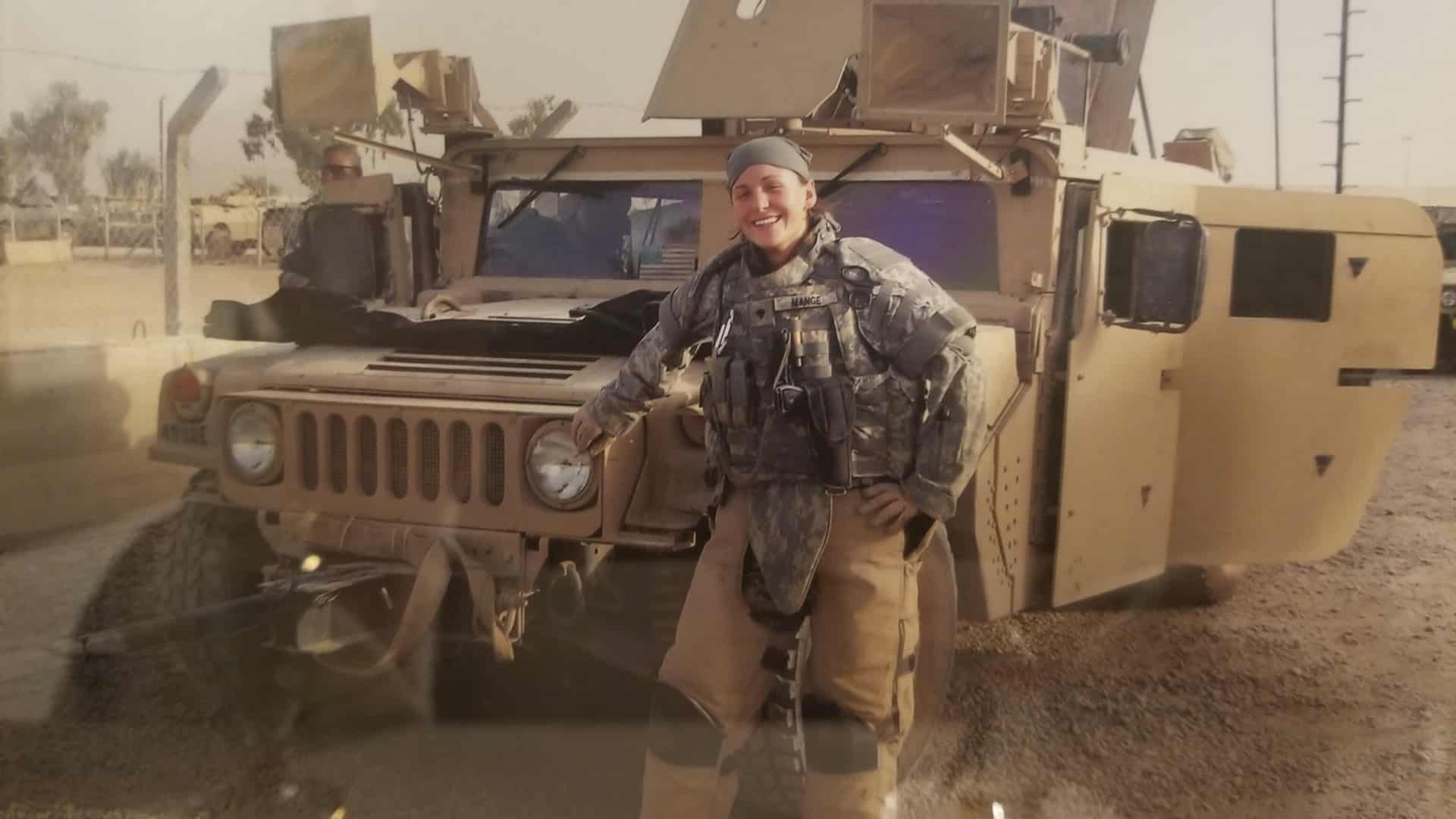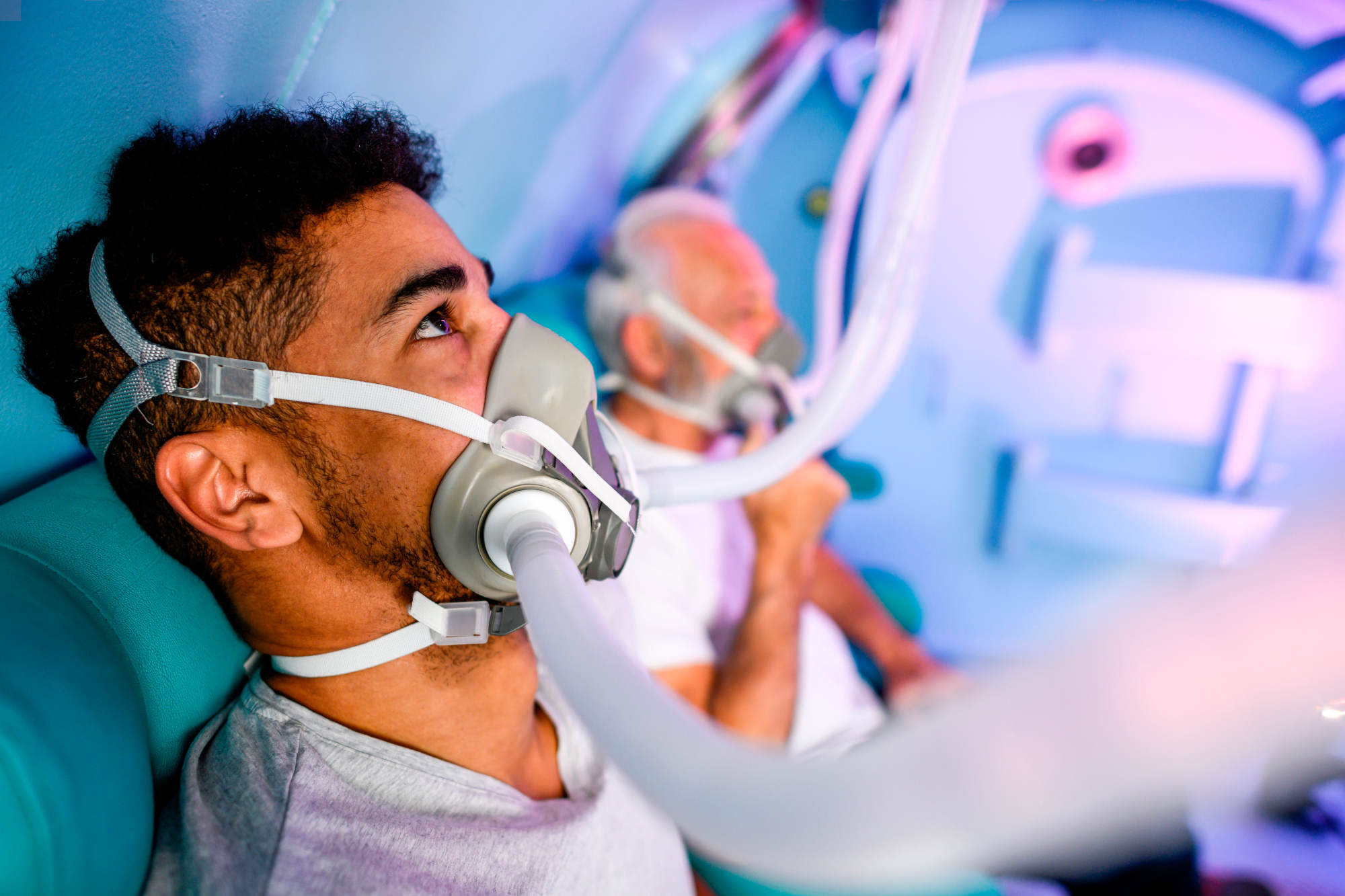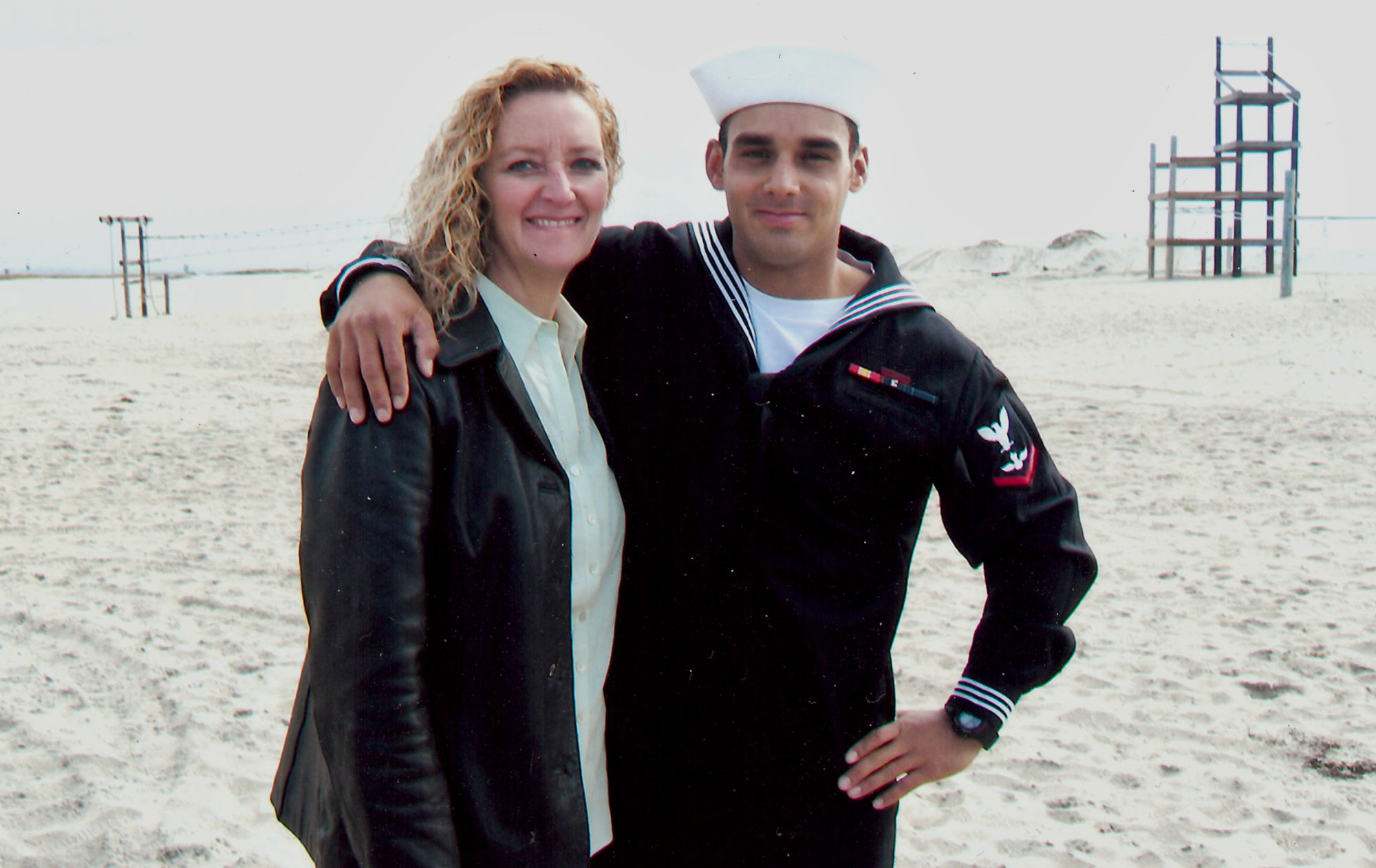
Top: Army Sgt. Margaux Mange experienced severe PTSD symptoms after serving in Iraq. She says hyperbaric oxygen therapy helped her symptoms significantly improve. Visual: Courtesy Margaux Mange
In 2007, United States Army Sgt. Margaux Mange was driving through Baghdad when the Humvee behind hers was hit with a bomb. She recalls grabbing a fire extinguisher and running toward the vehicle to try to rescue her best friend. But Mange was pulled back from the wreckage. Days later, Mange recalled, her left eye stopped blinking. A doctor told her it was Bell’s palsy, a form of temporary facial paralysis that may be triggered by stress. “I had a huge amount of survivor’s guilt,” she wrote in a text message to Undark.
Guilt wasn’t the only thing troubling Mange. Prior to her friend’s death, the blast from an improvised explosive device had thrown Mange’s head back into the turret of her vehicle, giving her a severe concussion and ultimately a traumatic brain injury, she said. In addition to receiving the Bell’s palsy and TBI diagnoses, Mange was told that certain nerves were damaged along one side of her head. She was flown to Denver, Colorado, for brain surgery. Back home in the United States, Mange realized her health was worse than anyone had imagined. She was besieged with excruciating headaches and had been diagnosed with a number of conditions, including post-traumatic stress disorder. “I had constant nightmares,” Mange wrote, and “no desire to leave bed.”
According to the Department of Veterans Affairs, anywhere from about 7 to 30 percent of U.S. combat veterans experience PTSD, a condition that emerges following an event in which a person experiences or witnesses something extreme — like the brutal killing of a friend. Symptoms may include nightmares, flashbacks, and severe anxiety. Among veterans, the most common treatment is a prescription drug, usually a type of antidepressant called an SSRI. However, many PTSD patients do not respond to these medications, and by one estimate, fewer than 20 to 30 percent of patients treated with SSRIs achieve full remission.
This situation is compounded by the fact that veterans with PTSD have high rates of co-occurring conditions, including depression, anxiety, substance misuse, and chronic pain. Like Mange, they are often prescribed multiple medications at once, a phenomenon known as polypharmacy, which increases the likelihood of side effects and drug-drug interactions.
Unsatisfied with her medication regimen and still struggling with both TBI and PTSD symptoms, Mange said she spoke with an Army counselor, who helped her enroll in a small study to test the effectiveness of a treatment often associated with undersea medicine: hyperbaric oxygen therapy. HBOT is a decades-old treatment in which patients enter a pressurized chamber and breathe pure oxygen, usually for about two hours. The oxygen saturates the blood and circulates throughout the body. This process has been shown to reduce inflammation and promote the development of new blood vessels, though the precise mechanisms are not fully understood.
But a handful of small studies — mainly conducted by physicians with ties to HBOT clinics — suggest that hyperbaric oxygen may improve PTSD symptoms and traumatic brain injuries in some patients, with limited side effects. These early results, coupled with hopeful anecdotes, have sparked intense interest and advocacy from veterans and their supporters, who are looking for better ways to treat the lingering wounds of war.
HYPERBARIC OXYGEN THERAPY was used in the 1930s to treat decompression sickness, a rare condition often associated with deep-sea diving. In the ensuing decades, physicians published clinical reports of their experiences using HBOT for a wide variety of purposes. As research uncovered the important role of oxygen in tissue repair, HBOT’s use as a treatment for chronic wounds became more common. In 2002, the Centers for Medicare & Medicaid Services decided to reimburse for treatments to heal diabetic foot ulcers. From there, the therapy took off.
Over the next 15 years, the number of HBOT clinics tripled to nearly 1,300, with hospitals “enticed by healthy Medicare payments” of about $450 per session, noted a 2017 investigation by Kaiser Health News. An expert review had concluded that the evidence to support HBOT for healing wounds was less than ideal, and even HBOT supporters criticized the rapid proliferation of clinics across the country. In the 2017 investigation, John Peters, executive director of the Undersea and Hyperbaric Medical Society, was quoted saying, “‘Some folks are chasing the money.’”
In 2021, the FDA released a consumer update, noting that HBOT has been approved for 13 conditions, including decompression sickness and carbon monoxide poisoning. The update cautioned patients to “be aware that some claims of what it can do are unproven. For example, HBOT devices are not proven to cure cancer, Lyme disease, autism, or Alzheimer’s disease.” (Some clinics still promote hyperbaric oxygen therapy as a treatment for these conditions and more.)
Hyperbaric oxygen therapy is a decades-old treatment in which patients enter a pressurized chamber and breathe pure oxygen, usually for about two hours.Visual: E+ via Getty Images
Inside a large hyperbaric chamber, many seats can accommodate several patients at once. The precise mechanisms by which HBOT affects the body are not fully understood. Visual: E+ via Getty ImagesAs HBOT clinics were proliferating across the country, veterans and their health care providers were grappling with an increasingly urgent problem: how to help combat veterans, including those recently returned from Iraq and Afghanistan, who were suffering with psychological problems and brain injuries — and were often being treated with polypharmacy.
“Stop the rampant over-medication of our troops with psychotropic and pain drugs,” wrote Allen Frances, an emeritus professor at Duke University School of Medicine, in a 2012 article about the military’s suicide epidemic. Frances, who chaired the task force that produced the fourth edition of the Diagnostic and Statistical Manual of Mental Disorders, or DSM-IV, recently wrote to Undark that “the biggest problem in the current treatment of PTSD is polypharmacy, which usually does more harm than good and raises the risks of addiction and overdose.”
Frances believes that the best available treatment for PTSD is cognitive behavioral therapy, “sometimes also including the cautious use of meds.” The VA also recommends psychotherapy as the first-line PTSD treatment.
Mange said that she has experienced some relief from psychotherapy. But when her physicians initially tried to treat her TBI symptoms, adding more and more drugs to her regimen, she said she started to feel like a guinea pig. When it comes to cases like hers, with overlapping symptoms from multiple diagnoses, she noted in an email, “there is no playbook and it’s like throwing darts in the dark.”
Mange participated in an initial round of 40 HBOT sessions. Halfway through, she began to feel furious — an anger she had not felt in years. “The anger kinda was an awakening,” she wrote to Undark. Soon thereafter, some of her PTSD symptoms subsided. Mange later completed a second round of treatment at a different clinic, after which, she said, she was able to stop taking the antidepressants that had been prescribed for PTSD.
Lee’s son Marc was a Navy SEAL who was killed in action in Iraq in 2006. After Marc’s death, Lee said his fellow soldiers began to talk with her about their mental difficulties. She started to notice that many veterans were trying to ease their symptoms “with alcohol, or marijuana, or other things” like psychedelic drugs. These strategies, Lee knew, could cause harm. She also suspected they were unlikely to lead to true healing.
In an interview with Undark, Lee additionally noted that for some veterans, psychotherapy can exacerbate symptoms. She specifically mentioned exposure therapy, in which veterans recount their traumatic experiences over and over, within the safe environment of a therapist’s office. Such recollecting can reduce PTSD symptoms, but some veterans have reported that exposure therapy made their symptoms worse. “It crushes these guys,” said Lee.
She began to read up on treatments offered to struggling soldiers, including those at elevated risk of suicide. This, she said, is how she first became aware of HBOT.
According to Lee, over the past 10 years, America’s Mighty Warriors has sponsored HBOT treatments for at least 300 veterans and soldiers, at a cost about $20,000 per veteran. Lee said her nonprofit usually finances 40 HBOT sessions. Recently, Aviv Clinics, an Israeli company that operates HBOT clinics in Florida and Dubai, pledged $1 million worth of treatments to America’s Mighty Warriors — enough to cover treatment for 20 patients, Lee said. Aviv Clinics is co-founded by Shai Efrati, a prominent HBOT researcher and advocate for the treatment.
“The majority of the time, they feel like they got better and it makes a lasting improvement,” Lee said. Some veterans don’t achieve a durable recovery, she noted, but in her view, these instances do not negate what she characterized as “testimony after testimony after testimony of SEALs that have said: ‘I would not be alive today if it wasn’t for you, and your foundation, and the healing that you’ve provided.’”
CAMPAIGNERS LIKE LEE and TreatNOW have advocated for lawmakers in several states to craft and pass legislation that provides veterans with better access to HBOT. In 2021, for example, North Carolina recognized hyperbaric oxygen therapy as a PTSD treatment and appropriated $150,000 from the state budget to help interested veterans. TreatNOW has also helped educate policymakers about the HBOT Access Act of 2021, a piece of federal legislation that would require the VA to provide HBOT to veterans with PTSD or a traumatic brain injury and who are “at high risk of suicide or self-harm” and have used at least two evidence-based treatment options for their condition.
U.S. Sen. Tommy Tuberville of Alabama, who introduced the bill, was quoted in a local news outlet, AL.com, explaining its rationale: “We’ve had 2.8 million young men and women that just fought in these two endless wars that we had in Iraq and Afghanistan,” he observed. “‘I think this would be a great opportunity to show our veterans we’re trying to do the best we can.’” A similar bill, introduced by U.S. Rep. Greg Murphy of North Carolina, is also making its way through Congress.
In her interview with Undark, Lee characterized all the recent HBOT legislation as baby steps. “What we need next is legislation that recognizes and approves that hyperbaric oxygen therapy is effective in healing our veterans.”
Debbie Lee with her son, Marc, just after he had graduated from Basic Underwater Demolition/SEAL Training. In 2006, Marc was killed during combat in Iraq. Visual: Courtesy Debbie LeeAccording to leading medical organizations, HBOT’s effectiveness for PTSD has not been proven. In 2021, the VA published an evidence brief pointing to studies that found HBOT does not alleviate symptoms of brain injury. The report also noted that, at the time, no clinical trial had been conducted on patients who had PTSD without a co-occurring brain injury. The Undersea and Hyperbaric Medical Society does not recognize HBOT as an evidence-based intervention for brain injuries or PTSD. The society’s executive director, John Peters, did note, however, that the organization is in the process of reviewing recent data on treating traumatic brain injuries.
Frances, the emeritus professor who worked on the DSM-IV, characterized hyperbaric therapy for PTSD as “greatly hyped,” given its spotty evidence base.
In 2017, the VA did implement a small program aimed at increasing HBOT access for veterans with treatment-resistant PTSD. But for advocates like Lee, the effort doesn’t go far enough.
IN A LARGE HOSPITAL COMPLEX outside Tel Aviv, Efrati, the co-founder of Aviv Clinics, leads the Sagol Center for Hyperbaric Medicine and Research at Shamir Medical Center in Israel. According to Sagol’s website, the center is the largest hyperbaric treatment facility in the world; its researchers are currently studying HBOT as a treatment for a wide range of conditions, including long Covid, age-related cognitive decline, and PTSD.
The question of trauma and how to heal it is especially salient in Israel, which has a large population of Holocaust survivors and their descendants. Military service is also mandatory for most Israeli citizens, and Palestinian and Jewish communities have endured decades of conflict.
In 2017, several Sagol researchers, including Efrati, helped run a small randomized controlled trial to test the efficacy of HBOT for female fibromyalgia patients with a history of childhood sexual abuse. They recruited 30 subjects. Fifteen were randomly assigned to receive 60 HBOT sessions and psychotherapy, while the other 15 received psychotherapy alone. The results, published in 2018, showed that the first group experienced significant improvement, as indicated by their responses to questionnaires that assess pain, quality of life, and PTSD symptoms, among other things. When the second group of study participants was later treated with HBOT, their fibromyalgia and mental health symptoms diminished, too.
More recently, Sagol researchers published a February 2022 paper in the journal PLOS ONE, describing the results of a small randomized controlled trial for combat veterans with treatment-resistant PTSD. For this study, 35 Israeli combat veterans were divided into two groups, one that received HBOT and one that did not. The former showed improvement in all classes of PTSD symptoms. In the control group, the participants’ symptoms stayed broadly the same.
In both studies, the participants who received the treatment also showed changes in the structure and function of certain brain regions implicated in PTSD. For example, the study authors noted that the combat veterans who received HBOT demonstrated improved activity in the hippocampus, a seahorse-shaped structure that other research suggests might atrophy in response to stressful experiences.
Aside from being small, the studies come with additional caveats. In the study of combat veterans, three of the co-authors disclosed that they work for or own stock in Aviv Clinics. Such conflicts of interest are not uncommon in clinical trials, but they have been flagged as a potential source of bias.
Additionally, outside experts noted that, in both studies, the participants clearly knew if and when they were receiving the treatment. This means some of the improvement could be attributed to the placebo effect, and not to the enriched oxygen.
In a statement emailed to Undark, Stacey Pollack, the national director for program policy implementation at the VA Office of Mental Health and Suicide Prevention provided the following comment on the February 2022 study of combat veterans: “After close review, the major limitation of the Sagol study is that the control group received no intervention. Therefore, the potential impact of a placebo effect on both the clinical and MRI findings is high and greatly limits the interpretation of these findings.”
Only in the past year or two, Bennet said, has the Sagol Center “started publishing trials that are properly blinded with a pretend treatment.” He later added by email that the “results need to be confirmed in multiple studies, although a single large multi-centered study might be very convincing.”
Bennett noted common obstacles to running a good HBOT study. The first one is money. “Oxygen is very cheap” and doesn’t stand to make any money for the pharmaceutical industry, which often pays for clinical trials. There’s also a large time commitment. “Asking someone to come and spend two or three hours with us, every day, Monday to Friday, for eight weeks,” Bennet said, is “a huge ask when people know that only half of them will get real treatment.”
DESPITE THE CHALLENGES, some physicians and researchers believe hyperbaric oxygen therapy holds enormous potential. “I am a great believer in HBOT,” Yehuda Melamed, a physician who founded the Israeli Navy’s first hyperbaric medical center, and who has helped establish HBOT clinics at several health systems, wrote to Undark. HBOT has shown promise as a new treatment for several conditions, wrote Melamed, and research continues to highlight the role of oxygen in many bodily processes. In 2019, the Nobel Prize in Physiology or Medicine was awarded to a trio of scientists for their discoveries about how human cells respond to changing oxygen levels.
Miki Doron, a clinical psychologist and former chief mental health officer of the Israel Defense Forces, said that the Sagol studies are impressive. Moving forward, he said, “I would like to see a large number of patients,” at least a hundred more, and a written, transparent treatment protocol.
The Sagol Center appears to be moving in that direction, running a double-blind trial with around 70 participants who have PTSD. They will have the results from that study, Efrati said, at the end of this year. In his view, the placebo effect is unlikely to have influenced his team’s earlier findings. He pointed out the treatment-resistant nature of his patients’ PTSD. “These patients received psychotherapy, pharmacological therapy — whatever, you name it,” Efrati emphasized. “They have taken everything.” And yet they did not experience any effect — placebo or therapeutic — with these other interventions.
Efrati also pointed to the results of a recent follow-up study of the combat veterans. Two years after their HBOT treatment, the veterans’ symptoms were still markedly improved. “Placebo holds as long as you take the placebo,” said Efrati. “It will not hold for two years.”
Back in the U.S., veterans are continuing to push for the treatment.
In 2013, three years after her final HBOT session, Mange joined a team of veterans on a journey to the South Pole, led by the military service organization Walking with the Wounded. “I had to physically pull everything that would help me survive on a sled behind me,” she wrote to Undark. “Life on the other side of my injuries was doable.” Today, she still experiences some headaches and PTSD symptoms, but they are manageable: “I am married to a wonderful man,” Mange wrote, adding that that she had a two-year-old and another kid on the way — a baby who is now 6 weeks old.
“Finally,” she wrote, “my life is in order.”
Gitit Ginat is an independent journalist for American publications and a former journalist at Haaretz, Israel’s leading broadsheet newspaper.
Cited by UnDark



